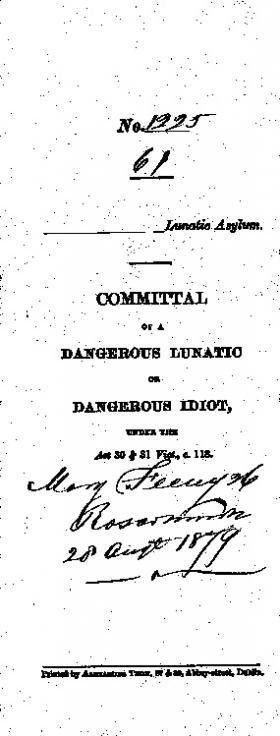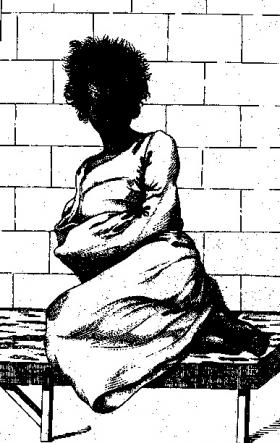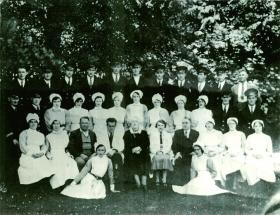‘tales from the big House’ the Connacht District Lunatic Asylum in the late nineteenth century
Published in 18th-19th Century Social Perspectives, 18th–19th - Century History, Features, Issue 6 (Nov/Dec 2005), Volume 13
Bell-tower of the Connacht District Lunatic Asylum (now St Brigid’s Hospital), Ballinasloe.
Connacht District Lunatic Asylum
This article will focus on the Connacht District Lunatic Asylum (CDLA, now St Brigid’s Hospital), opened in Ballinasloe, Co. Galway, in 1833 and one of the earliest of the Irish district asylums. It was intended for the care of ‘curable lunatics’ and opened in a spirit of optimism with regard to its progressive role in public health. Its history, however, is one of continual struggle: to prevent the admission of unsuitable cases, to secure additional funding and to offer reasonable standards of care under difficult conditions. In common with the majority of other District Asylums, the CDLA was continually overcrowded, housing in November 1900, for example, 1,165 patients in accommodation designed to hold 840. Its evolving role in Irish society throughout the nineteenth century, then, throws some interesting light on public perceptions of the insane, the authority of the medical profession and changing social mores.
The nineteenth century may fairly be described as the century of the asylum, with a worldwide growth in the institutional care of the insane. Within this large picture the Irish case is especially interesting. Ireland was one of the earliest states to embrace the asylum system, and by the end of the nineteenth century had experienced one of the most rapid proportionate growths in asylum admissions in the world. When one considers that Ireland’s population actually declined sharply from mid-century, this growth is all the more startling. Yet early advocates of asylums had neither proposed nor anticipated that institutional care should be made available on such a scale. Rather, it had been hoped that only nine 150-bed asylums would prove sufficient to care for the whole of the country, and indeed several commentators argued that this would prove a gross over-provision.
Dangerous Lunatics Act
There are a number of factors that help to explain the sharp increase in lunatic committals in Ireland. The most important of these is the legislation used to govern lunacy provision in the country. In the early years of the nineteenth century there were no voluntary admissions as we understand them: every patient had to be committed on the evidence of another, very often a family member.
There were two methods of committal to Irish asylums: in the first instance by straightforward application to an asylum, and in the second through admission under the Dangerous Lunatics Act (DLA), by warrant of the lord lieutenant. Passed in 1838, the Act applied only to Ireland and allowed quite exceptional powers of committal to ordinary citizens. Any person could make an unsubstantiated allegation of insane behaviour against another. On the basis of this alone, the individual could be arrested, brought before two justices of the peace, examined by a medical officer and, if judged insane, committed initially to gaol, and thence to the appropriate district lunatic asylum. Proof of insane behaviour did not have to be provided, and while some patients were independently witnessed threatening or actually committing an assault, the majority were not. Allegations ranged from physically striking a complainant with fists or tools, through threatening or abusive language to a mere peculiarity of manner or expression. The point of the Act was that the patient be classed as dangerous, to self or others, and the accusation against them required that they be ‘discovered and apprehended . . . under circumstances denoting a derangement of mind, and a purpose of committing an indictable crime’. Ireland was the only country in this period to make a legal link between insanity and criminality, and it was an association that had a detrimental effect upon those who fell under its provisions.

Committal form of Mary Feeny, Co. Roscommon, committed 27 August 1879.
Another major problem with the DLA was the fact that many of the alleged lunatics processed under the Act spent periods of up to twelve months in gaol before being transferred to the asylums, thereby further strengthening the perception that they were primarily criminals rather than individuals labouring under mental illness. Moreover, the lengthy stay in prison often weakened family ties, with the effect that patients who came from gaol, especially those suffering from genuine mental distress, often arrived with little information regarding place of birth or residence, details of next of kin, or even basic information as to age and occupation.
The problems caused by the generous committal powers of the DLA were compounded by the most important element in the Act: no physician or asylum manager had the power to refuse a patient presented under the DLA. Thus even in those cases where the asylum physician (later known as the resident medical superintendent (RMS)) examined an individual and declared them to be sane, they were still forced to admit that individual to the institution.
Early work in psychiatric history interpreted asylums largely as sites of control and repression, and the powers contained in the DLA would initially seem to confirm this interpretation. It was broadly alleged that the growth of such institutions across Europe was intimately linked with increasingly interventionist governments, and a growing intolerance for any form of deviant behaviour. In this model, the patient was seen as a relatively helpless victim of state and medical power, and asylums as monolithic institutions that actively sought to draw innocent individuals behind their walls. However, more recent work has demonstrated that this broad picture, while accurate to a limited degree, is a gross oversimplification of a complex and evolving system that was highly responsive to local and national politics, changing economic climates, and significant social change. As far as Ballinasloe was concerned, there were two principal groups that regulated entry to the asylum: the officials associated with the workhouse and gaol systems, and family members who, for a variety of reasons, were willing to commit relatives to the institution.
Opportunity to rid gaols and workhouses of difficult inmates
The former group were amongst the earliest and most enthusiastic supporters of the district asylum system. When the Ballinasloe asylum was in the process of construction in the early 1830s, there was some concern that its accommodation for 150 patients was a gross overestimation of the number of known lunatics in its catchment area of counties Galway, Roscommon, Sligo, Mayo and Leitrim. Some critics had argued that there were not 150 lunatics in the whole of the country, and that the asylum must inevitably stand half-empty.
In November 1833, as the asylum neared readiness, the board of governors advertised for patients, announcing ‘that the Connacht District Lunatic Asylum at Ballinasloe is prepared for the reception of patients, and that printed forms of admission can be had at the asylum’. The announcement proved unnecessary, as the first rush of patients came not from families who had read the advertisement in the papers but from the region’s workhouses and gaols. The first 21 admissions came en masse from the poorhouse at Castlebar, and the next large group, of 23, from the old gaol at Roscommon. Other workhouse and gaol managers were quick to seize upon this opportunity to rid themselves of long-stay or difficult inmates, and within a mere eighteen months of its opening the asylum was almost full. Of the 146 patients in residence, ‘86 have been admitted from the several gaols of the province who with a few exceptions have been incurable, epileptic or idiotic and are therefore likely to remain in the asylum during life’.
The board of governors protested against these admissions, arguing that the asylum had been established for the care of curable lunatics, but they were relatively powerless to stem the flow of inmates from gaols and workhouses. In Ireland, unlike the rest of the United Kingdom in the nineteenth century, the asylum system came under the administrative umbrella of the prison system, and the inspector-general of prisons (IGP) was also the inspector of asylums. There was a consequent tendency to regard asylums not primarily as places of cure but as convenient annexes to prisons, where disturbed or difficult inmates could be sent. In 1835 the IGP tried to transfer 60 inmates from Sligo gaol to Ballinasloe. When the board protested that their institution was being swamped by long-stay, institutionalised patients who stood little chance of recovery, they were reminded of their obligations in no uncertain terms:
‘The commissioners of any lunatic asylum are empowered to receive of idiots and epileptics etc., a number not exceeding half of their establishment (this in Ballinasloe would be 75) and even to build additional accommodation for them.’
The board had little option but to accept the mass transfers, securing in return for their unwilling assistance the promise that they could build additional accommodation for the unexpectedly large numbers of individuals who, to general surprise, now apparently needed institutional care.
The board at Ballinasloe did not in principle object to patients from gaols as long as they were subjects likely to respond to asylum treatment. Indeed, even in those cases where individuals had been imprisoned for so long that their chances of recovery or even improvement were unlikely, the board felt that the asylum was a more appropriate place for them because of the casual cruelty with which many were treated in the prison system. Mentally ill prison inmates tended to be singled out for harsh treatment, and the inspectors frequently commented on the fact that they were more often restrained (through the use of strait-waistcoats and wrist and ankle muffs), and the warders far less tolerant of them, than the ordinary criminals. The latter often objected strenuously at their forced association with lunatics, and made unfounded accusations of assault against them in order to speed their removal to the district asylums. They would, however, take pains to ensure that they themselves did not take this route. The prison and asylum inspectors noted that some prisoners attempted to evade their sentences by pleading insanity, in the expectation that if they miraculously recovered their wits in the asylum they would be discharged. The reality was that criminals who were deemed to be insane at the time of the crime, at trial or upon imprisonment were transferred to the appropriate district asylum or, after 1850, to the criminal asylum at Dundrum, Dublin, depending on the severity of the crime. If they regained their sanity, they returned to gaol to serve the remainder of their sentence. Experience showed that prisoners who feigned insanity begged to be returned to gaol almost immediately, so deep was their dislike of forced association with the mentally ill.

Painting by André Broussais of French psychiatrist Charcot presenting ‘a hysterical patient’ to his colleagues at the Salpetrière Hospital, Paris. (Neurological Hospital, Lyon)
‘Congenital idiots’ and the ‘tranquilly demented’
Although prison administrators gleefully grasped the opportunity offered to them by the opening of the district asylums, the greatest administrative conflict occurred with the managers of workhouses, who saw in the asylums an opportunity to clear out long-stay inmates. Most Irish workhouses had insane wings, or at the least some accommodation for the senile or demented. However, the opening of asylums such as Ballinasloe provided an opportunity to remove substantial numbers of inmates who represented little threat to their fellow workhouse residents. Workhouses had a legal obligation to care for pauper inmates who were ‘tranquilly demented’—in other words, the senile and aged rather than the mentally ill, although they were also supposed to accommodate pacific pauper lunatics who were incurable. In contrast to the position in gaols, where the cost of maintaining inmates was the highest of these three ‘care options’, workhouses proved the cheapest form of accommodation for the destitute and dependent poor. Nevertheless, the urge to push innocuous, and for the most part elderly, inmates from the workhouses to the asylums continued throughout the nineteenth century.
The mentally handicapped were another group over whom the asylum management struggled. The CDLA was specifically intended for the care of curable pauper lunatics, and the only circumstances under which they should accept those they described as ‘congenital idiots’ were if they were admitted as ‘dangerous idiots’, under the Dangerous Lunatics Act. Year after year, however, patients were sent to the CDLA who represented no threat whatsoever but whom the workhouse managers wished to discharge. There was always a keen desire to remove ‘wet and dirty’ inmates from workhouses, and despite the unsuitability of the accommodation, especially for children, many wound up living their lives in the district asylums.
One such case was admitted to Ballinasloe in 1896. The accompanying documents declared that the boy, a ‘deaf and dumb idiot’ of 17, had been living in Loughrea workhouse, Co. Galway, from the age of four. He was sent from there to ‘Cabra institution’, where he lived for seven years, but was returned to Loughrea ‘on account of his incurably dirty habits’. On being accused of throwing a stone at a fellow inmate, he was sentenced to one month’s imprisonment with hard labour in Galway gaol. The gaol discharged him as a dangerous idiot to Ballinasloe, where he remained until his death. As the boy was shunted back and forth, the local district inspector attempted to trace his relatives, but found that ‘the parents and relatives of the boy are believed to be dead, and I can get no information concerning them except that the father and mother were first or second cousins and lived somewhere between Athenry and Craughwell’. The asylum was often the final refuge for individuals such as this, who had no relatives willing or able to take responsibility for them, and they represented a considerable proportion of the long-stay patient population throughout the nineteenth century at Ballinasloe.
Majority of relatives concerned about the welfare of patients
The committal process in Ireland was clearly open to a great deal of abuse, and the Dangerous Lunatics Act was a powerful weapon in irresponsible hands. However, despite the obvious deficiencies of the Irish legislation, and the many cases of dubious committal it allowed, the majority of relatives were in fact most concerned about the welfare of patients, and went to considerable trouble to ensure that their stay was as beneficial as possible. Community attitudes towards the asylum were, as one would expect, complex and often contradictory. What is clear, though, is that people not merely accepted the district asylums but increasingly viewed them as a resource. It is their utilisation of the system that really lies behind its expansion, although the role of the medical profession, an increasing centralisation of Irish government and an altered social landscape, especially in the post-Famine years, all played important parts.
Analysis of the committal warrants to Ballinasloe indicates that family members played an active part in presenting a complaint to the police and in submitting evidence of insane behaviour to the asylum. However, this is not to say that there was a simplistic model of committal of weak or vulnerable family members against their will. On the contrary, the warrants provide evidence that families frequently made strenuous efforts to care for mentally ill individuals at home, before turning to the asylum in the hope of a cure. In addition to providing information on the behaviour that precipitated the committal—most often a violent assault—relatives had to answer a series of questions on the patient’s medical history, including any prior evidence of insane behaviour or earlier attacks of mental illness. In a majority of cases the patient had had previous incidents, and had often been violent for periods lasting from a number of days to, in some cases, several years, before the committal took place. A frequent statement was that the patient had to be ‘constantly watched’ to prevent assaults or suicide attempts, and as periods of maniacal behaviour often coincided with a refusal or inability to sleep, whole families, including cousins and in-laws, were drafted in to share the supervision. In many of these cases, families used the asylum as a respite from the demands of care, committing patients when they became unmanageable at home and removing them once they again felt able to cope.

An 1838 French engraving of ‘a maniac during an attack’. (Library of the Faculty of Medicine, Paris)
The concern that many felt regarding the welfare of their relations is borne out by the letters they sent, to the patients themselves as well as to the physician, asking for the most recent news on their mental and physical conditions. Even great distances did not necessarily sever close ties, as concerned relatives, very often grown children, wrote back letters of enquiry to Ballinasloe. One daughter maintained a correspondence with her father, admitted in 1899. She sent him letters every month or so with family news, descriptions of her life in New York and encounters with other Irish migrants. She visited him in 1909 on a return trip home, and regularly sent back money. The asylum authorities encouraged contact with close relatives, and responded promptly to queries regarding health and mental condition.
Siblings could also be scrupulous regarding the fate of patients. A young man of 28 was admitted to Ballinasloe in 1899, committed by his mother and his third cousin. Over the years, his brother maintained contact, writing from his home in Dundalk as late as 1942 to ensure that the patient was receiving his old age pension. He also sent regular money orders as his brother’s share in their small inheritance. Even when many years had passed, relatives made periodic contact. One woman wrote from Glasgow enquiring after her brother, who had been admitted 36 years earlier, saying that she was ‘Feeling anxious about a brother of mine I seen 29 years ago, or perhaps a little before that’. She and her two sisters, now all living in Glasgow, were unsure of his mental state: ‘We are very anxious to know anything concerning him. We will be much obliged. If he is alive, do you think we could write to him, and would he understand.’ The RMS sent an account of his health to her, and she did indeed write to him until his death four years later in 1939.
The common perception that families sought to hide the fact that a relative had been committed to Ballinasloe was certainly true in many cases. However, the records reveal that not only did people visit when possible, write frequently and send money both for their support in the institution and as pocket money, but they generally tried to ensure that they removed the body at death, for burial in a family plot as opposed to the asylum graveyard. The elderly father of one admission in 1899 wrote to the RMS some months after his son’s committal, asking: ‘you will please send me a telegram if my son . . . should die, as I will DV go for his remains and bring a coffin with me’. The asylum always sent notice of grave illness and death (relatives had three days in which to collect the remains), but as these often took place many years after admission the contact details given on the committal warrants could be hopelessly out of date. Many such notices were returned to the institution, marked ‘gone to America’, ‘emigrated’ or ‘deceased’ on the envelopes. These testify to the efforts made by the postal service to track down relatives, and often three or four addresses, presumably provided by a succession of neighbours, have been written on the front.
Occasionally distant relatives were contacted, and in many cases were not prepared to bear the cost of collection and burial, instructing the asylum to deal with the remains. Others, however, were anxious to show proper respect, such as the cousin who was traced in 1908 and wrote immediately to the RMS: ‘Dear Sir, I got your letter this morning about L___ K___’s death. I am going to see him interred [at the asylum] tomorrow as I am sorry I am a stranger here and has no one to take him home. Hope he will not be buried until I get there.’ Of course, not all relatives were so concerned about the fate of patients. In many cases one finds admissions for spurious reasons, by families who immediately emigrated to America. They apparently feared that they would not gain entry to the United States if one of their number exhibited peculiar behaviour, for any reason. These patients, who were not insane, were committed under the all-encompassing DLA, and swiftly found that they were without resources, having no family or property to return to. The Connacht District Lunatic Asylum then became their home, often for the remainder of their lives. In these cases it did indeed operate as an asylum, a place of refuge for those rejected by society.

Staff photograph of St Brigid’s c. 1935.
Oonagh Walsh is Senior Lecturer in History at the University of Aberdeen, currently on Wellcome Trust research leave to complete a book on nineteenth-century Irish psychiatry.
Further reading:
P. Bartlett and D. Wright (eds), Outside the walls of the asylum: the history of care in the community 1750–2000 (London, 1999).
M. Finnane, Insanity and the insane in post-Famine Ireland (London, 1981).
J. Melling and B. Forsythe (eds), Insanity, institutions and society, 1800–1914: a social history of madness in comparative perspective (London, 1999).
J. Robins, Fools and mad: a history of the insane in Ireland (Dublin, 1986).
















